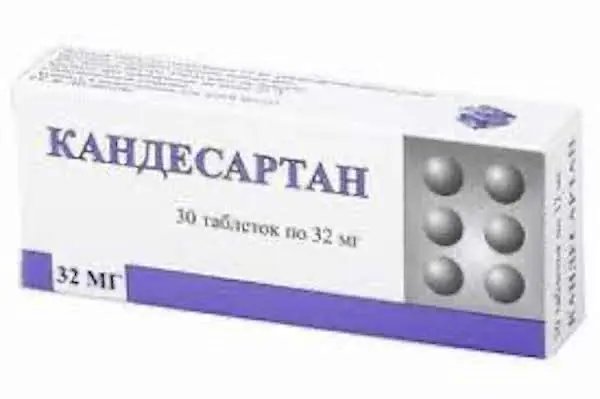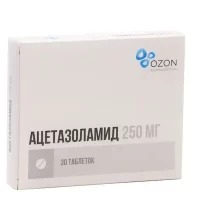Description
Candesartan Pharmacodynamics
Angiotensin II is the main hormone of the renin-angiotensin-aldosterone system, which plays an important role in the pathogenesis of arterial hypertension, heart failure and other cardiovascular diseases. The main physiological effects of angiotensin II are vasoconstriction, stimulation of aldosterone production, regulation of water-electrolyte homeostasis, and stimulation of cell growth. All these effects are mediated by the interaction of angiotensin II with angiotensin type 1 receptors (AT1 receptors).
Candesartan is a selective angiotensin II type 1 receptor antagonist (AT1 receptors). Candesartan does not inhibit angiotensin-converting enzyme (ACE), which converts angiotensin I to angiotensin II and degrades bradykinin; it does not affect ACE and does not lead to accumulation of bradykinin or substance P. When comparing candesartan with ACE inhibitors, cough development was less common in patients treated with candesartan cilexetil. Candesartan does not bind to other hormone receptors and does not block ion channels involved in the regulation of cardiovascular function. Blocking of angiotensin II AT1 receptors results in a dose-dependent increase in renin, angiotensin I, angiotensin II activity and decrease in plasma aldosterone concentration.
Indications
– Arterial hypertension.
– Chronic heart failure and left ventricular systolic dysfunction (decreased LVEF ≤ 40%) as adjunctive therapy to angiotensin-converting enzyme (ACE) inhibitors or when ACE inhibitors are intolerant (see section “Pharmacodynamics”).
Contraindications
Hypersensitivity to candesartan or other components of the drug.
Pregnancy and breastfeeding (see section “Administration during pregnancy and breastfeeding”).
Severe liver dysfunction and/or cholestasis.
Lactose intolerance, lactase deficiency and glucose-galactose malabsorption syndrome.
The use of candesartan cilexetil in combination with drugs containing aliskiren in patients with diabetes mellitus and/or with moderate or severe renal dysfunction (glomerular filtration rate less than 60 ml/min/1.73 m2 body surface area).
Concomitant use with ACE inhibitors in patients with diabetic nephropathy.
Age under 18 years (efficacy and safety have not been established).
Dosage and administration
- Candesartan should be taken once daily regardless of meals.
- Arterial hypertension
The recommended starting and maintenance dose of Candesartan is 8 mg once daily. Patients who require further BP reduction are recommended to increase the dose to 16 mg once daily. Patients who have not been able to reduce their blood pressure sufficiently after 4 weeks of taking Candesartan at a dose of 16 mg once daily are recommended to increase the dose to 32 mg once daily. - Therapy should be adjusted according to blood pressure levels. The maximum antihypertensive effect is achieved within 4 weeks from the start of treatment. If therapy with Candesartan does not reduce blood pressure to optimal levels, it is recommended to add a thiazide diuretic to therapy.
- Elderly patients
In elderly patients, there is no need to adjust the initial dose of the drug. - Patients with impaired renal function
In patients with mild to moderate renal impairment (creatinine clearance
30-80 ml/min), including patients on hemodialysis, the initial dose is 4 mg (1/2 of 8 mg tablet). - The dose should be titrated depending on the therapeutic effect of the drug.
Clinical experience of using the drug in patients with severe renal impairment (creatinine clearance < 30 ml/min) or terminal renal failure (creatinine clearance less than 15 ml/min) is limited (see section “Cautionary Note”). - Patients with impaired liver function
The initial daily dose in patients with liver dysfunction of mild to moderate severity is 4 mg once daily (1/2 tablet of 8 mg). Increased doses are possible if necessary. Candesartan is contraindicated in patients with severe hepatic impairment and/or cholestasis (see section “Contraindications”). - Concomitant therapy
The use of Candesartan together with thiazide-type diuretics (e.g. hydrochlorothiazide) may increase the antihypertensive effect. - Hypovolemia
The recommended starting dose of Candesartan is 4 mg once daily (1/2 8 mg tablet). - Chronic heart failure
The recommended starting dose of Candesartan is 4 mg (1/2 of 8 mg tablet) once daily. Increase the dose to 32 mg once daily or to maximum tolerated dose by doubling it at intervals of at least 2 weeks (see section “Indications”). - Special patient groups
Patients of elderly age and patients with kidney or liver dysfunction do not require change of the initial dose. - Administration in children and adolescents
Safety and efficacy of Candesartan in children and adolescents (< 18 years) has not been established (see section “Contraindications”). - Concomitant therapy
Candesartan may be coadministered with other agents used for treatment of chronic heart failure, e.g. ACE inhibitors, beta-adreno-blockers, diuretics and cardiac glycosides (see sections “Special Precautions”, “Pharmacodynamics”).





